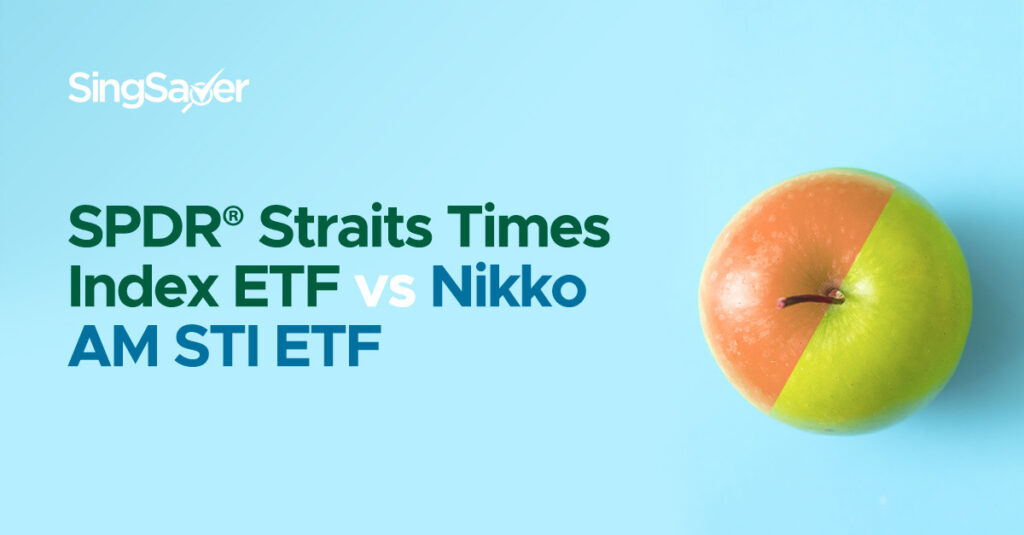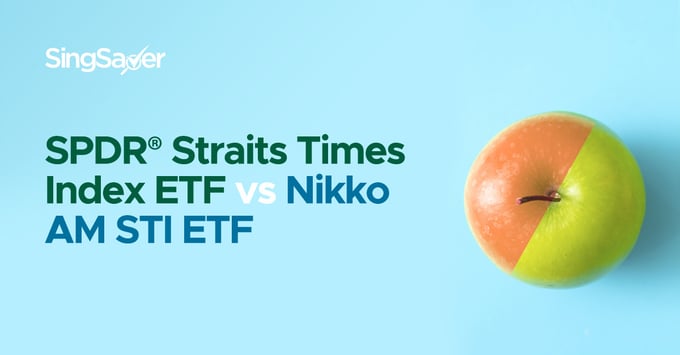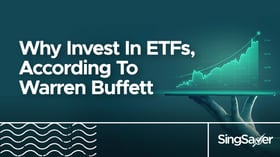
Choices are never easy. That’s why, we do the math, so you don’t have to. Compare This, a SingSaver series, is here to help make decisions a little easier for you.
An apple to apple comparison in true fashion, we look at the similarities and differences of the two exchange traded funds that track the Straits Times Index — SPDR® Straits Times Index ETF and Nikko AM STI ETF.
Investors that are looking to invest in the Straits Times Index (STI) would have undoubtedly heard about the two different Exchange Traded Funds (ETFs) available: Nikko AM STI ETF and SPDR STI ETF.
Here’s a comparison of these two options available for investors to help you figure out which is the better choice for you.
- Why invest in an STI ETF
- Comparison table
- Why choose SPDR® Straits Times Index ETF
- Why choose Nikko AM STI ETF
What exactly is the STI ETF?
The Straits Times Index (STI) is an index that comprises the top 30 companies listed on the Singapore Exchange (SGX), weighted based on their market capitalisation. This includes the likes of DBS, OCBC, UOB, ComfortDelGro, Sheng Siong, CapitaLand, Dairy Farm and more.
The STI is often seen as the benchmark for the Singapore equities market, much like how the S&P 500 is seen as the benchmark for the US market. It is also sometimes affectionately called the blue-chip index by investors, considering that the stocks that make up the index are mainly blue chip stocks.
The Nikko AM STI ETF and the SPDR STI ETF are both exchange traded funds (ETFs) that track and aim to replicate the performance of the STI.
Why do people choose to invest in an STI ETF?
1. Dividends
Be it the SPDR STI ETF or the Nikko AM STI ETF, investors will be rewarded with dividends of about 4% yield twice a year.
2. Diversification
As the STI consists of the top 30 companies on the SGX, this provides instant diversification for investors as the companies span different sectors and industries. However, do also keep in mind that although there is diversification, the STI still heavily comprises bank stocks by weightage.
3. Affordability
Purchasing the STI ETF is an affordable way to invest in the top companies on the SGX. On 23 February 2021, the SPDR STI ETF (SGX: ES3) closed at S$2.90. This means that purchasing 100 lots of the STI ETF would cost just S$290.
You also get a piece of each of the 30 different companies. This would be difficult (not to mention expensive) for you to replicate on your own. For example, 100 lots of a stock like DBS — trading at around S$25 per share — would already cost S$2,500.
4. Highly liquid
The STI ETF is traded on the open market. This means that you can buy and sell the ETF any time you wish, as long as you have your brokerage account and Central Depository (CDP) account opened.
SPDR STI ETF vs Nikko AM STI ETF: Which to choose?
Both the SPDR STI ETF and Nikko AM STI ETF seek to track the performance of the STI. Here’s a look at the similarities and differences between the two.
| SPDR STI ETF (SGX: ES3) | Nikko AM STI ETF (SGX: G3B) | |
| Dividends | S$0.115 per share Paid semi-annually | S$0.1268 per share Paid semi-annually |
| Last traded price (22 Feb 2021) | S$2.878 | S$2.93 |
| Performance (STI Benchmark: 1 year: -4.15% 3 years: -2.57% 5 years: 5.94%) | 1 year: -4.85% 3 years: -2.88% 5 years: 5.49% | 1 year: -4.88% 3 years: -3.07% 5 years: 5.37% |
| Total Expense Ratio | 0.30% p.a. | 0.30% p.a. |
| Tracking Error | 0.2919% (Rolling 1-year annualised tracking error, as of 31 Jan 2021) | 0.17% (3-year annualised tracking error, as of 31 Jan 2021) |
| Inception | 11 Apr 2002 | 24 February 2009 |
| Assets Under Management (AUM) | S$1,667.40 Million as of 22 Feb 2021 | S$508.00 Million as of 22 February 2021 |
| Platforms offering monthly investment plans for the ETF | - PhillipCapital’s Share Builders Plan - FSMOne Regular Savings Plan | - DBS Regular Savings Plan - OCBC Blue Chip Investment Plan - FSMOne Regular Savings Plan |
From the table above, notably, cost isn’t a big differentiating factor between the two, considering that they both have a total expense ratio of 0.30%. They can also both be purchased directly on the SGX with your brokerage account.
Why choose the SPDR® Straits Times Index ETF?
Key differentiating point: Better performance over the years
For all three performance comparison points (1 year, 3 years and 5 years), SPDR STI ETF has shown to have better returns compared to Nikko AM STI ETF. Even during 2020 when we saw the market plunge in March, SPDR STI ETF’s one-year performance dropped less than Nikko AM STI ETF.
SPDR STI ETF also has a larger AUM compared to Nikko AM STI ETF.
How to buy SPDR STI ETF?
You can purchase the SPDR STI ETF directly from the market with your brokerage account. This leaves the decision making in your hands — you decide when and how often you’d like to purchase the ETF.
Alternatively, you can also invest in the SPDR STI ETF monthly with the following platforms.
- POEMS Share Builders Plan (SBP): You could start with just S$100 per month. Besides the SPDR STI ETF, there are more than 40 other counters for you to choose from. For less than two counters, you’ll incur a fee of S$6. Alternatively, if you have a POEMS brokerage account, you can also set up a recurring plan to purchase the SPDR STI ETF monthly, where prevailing account brokerage rates will apply.
- FSMOne Regular Savings Plan: S$50 a month is enough for you to start a regular savings plan with FSMOne. FSMOne provides the greatest flexibility, allowing you to purchase either the Nikko AM STI ETF or the SPDR STI ETF.
Why choose the Nikko AM STI ETF?
Key differentiating point: Higher dividend per share
In 2020, those that invested in Nikko AM STI ETF would have received S$0.1268 per share, compared to the S$0.115 per share given to investors of SPDR STI ETF. Granted, the dividend yield would also depend on the share price of the ETF. However, the price of both are highly similar and both ETFs pay out dividends semi-annually.
Nikko AM STI ETF also has a lower tracking error. However, this isn't a direct comparison considering that Nikko AM STI ETF's tracking error is annualised across 3-years, while SPDR STI ETF's tracking error is a rolling 1-year annualised tracking error.
How to buy Nikko AM STI ETF?
Besides purchasing Nikko AM STI ETF directly from the market with your brokerage account, banks such as DBS and OCBC offer Nikko AM STI ETF as an investment fund choice for their regular savings plans.
- DBS/POSB Regular Savings Plan: With a minimum of just S$100 a month, the regular savings plan is easy to set up — no trading or CDP account required. This comes with a sales charge of 0.5% or 0.82%. You have four different ETFs to choose from under the DBS/POSB regular savings plan, with Nikko AM STI ETF as the option for Singapore equities.
- OCBC Blue Chip Investment Plan (BCIP): Offering 21 different counters, the OCBC BCIP allows you to access blue chip shares and Singapore ETFs from S$100 a month.
Read these next:
Investing In Exchange Traded Funds (ETFs): A Newbie’s Guide To Getting Started
Uniquely Singaporean Things We Do To Accumulate Wealth
Regular Savings Plan (RSP): What They Are And The Best Ones To Invest In
Dollar-Cost-Averaging vs Lump Sum Investing In Singapore: Which Should You Choose?
DBS, SIA & Sheng Siong: Beginner’s Guide To Blue Chip Stocks In Singapore
Similar articles
Best ETFs In Singapore For Tracking Stocks, Bonds And REITs
Straits Times Index: Top Blue-Chip Companies (And What They Do)
Investing In Exchange Traded Funds (ETFs): A Newbie’s Guide To Getting Started
How to Build a Passive Income Portfolio Using ETFs (And Why You Should)
This Is One S&P 500 ETF You Might Want To Avoid
Regular Savings Plan (RSP): What They Are And The Best Ones To Invest In
DBS, OCBC or UOB: Which Bank Gives You The Greatest Dividend Yield?
Regular Shares Savings (RSS) Plans: Complete 2019 Guide










